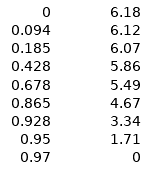Accurate test of CLAITE 10W 5V solar panel
I tested the panel recently, and got a strangely-large short-circuit current:
https://bkhome.org/news/202104/comparison-of-claite-10w-and-se05-5w-solar-panels.html
I have had this anomaly before. What is happening is that the pulses
from the switching regulator are confusing the digital multimeter. At
the higher load, the output filtering capacitor is not smoothing the
pulses as effectively, and the pulses are upsetting the multimeter. So
that over-2A short-circuit current is wrong.
Today was sunny, at least in the morning, and tested the panel with
the switching regulator removed, directly connected to resistance loads.
Today is April 14, 2021, Perth Western Australia, bright blue Autumn
sky. Test conducted from 10.45am to 10.50am.
Solar irradiance (intensity) measured at start was 870W/m2, at end 880W/m2. Ambient temperature was 24degC. Negligible breeze.
The panel was sitting in the sun about 5 minutes prior to testing.
About midway through the test, took a reading of the temperature at
front of panel, IR reader held about 100mm away, reading was 47degC.
Here are the readings, and a plot:


I estimate peak power point is about 4.8V @ 0.84A, which is 4.05W.
So, if you reckon the vendors are cheats, advertising the panel as 10 watts, you would be right.
Note however, that they are claiming 10W with a cell temperature of
25degC and solar irradiance of 1000W/m2. Power output drops as
temperature rises, and if I guess -0.3% per degC rise, then the rise
from 25degC to 47degC will cause a power loss of 7%.
Then there is the irradiance. If I assume power output will climb
linearly with increase of irradiance, then that 4.05W would become 4.6W.
Then factor in the cell temperature, and we get the power output at
1000W/m2 irradiance and 25degC as 4.97W.
Just about half what the vendor claims!
It does make it hard for those vendors on eBay and Aliexpress that do
the right thing and publish correct power output.
However, they are good photovoltaic cells, more efficient than those
in my SE05 panel. So the panel is a good choice for hiking, where we are
chasing lighter weight.
What the vendor does not say, is what coating is used on top of the
cells. As I understand it, the cheapest is epoxy-resin, then there is
PET, then better still ETFE. The cheap option, the coating will perish
in the sun, whereas ETFE will give you 10 years lifetime (I think, from
memory).
For someone who will take the panel hiking, perhaps perched on top of
their backpack, it probably won't matter what coating is used, as
hikers are only going to be out there occasionally.
However, something to think about is the switching regulator. That
will be sitting on top of your backpack, right near your head. It
oscillates at about 300KHz and radiates much higher frequency
components. It is, effectively, a radio transmitter.
There you are, out in the pristine wilderness, living a natural life.
yet you have this thing on your backpack radiating RF into your head!
It might not be doing any harm, but for me it really does not fit
with being back to nature. That is one of the reasons that I intend to
replace the regulator with a linear regulator. Look at earlier blog
posts for my design, and soon I intend to post a design that will handle
up to 2A. My regulator is small, efficient, and replaces the switching
regulator, and does not radiate any RF. Watch my blog, new regulator
design expected soon! Note, I found a vendor who sells a raw panel
without regulator, and has PET coating, so have ordered that and will
report back.
Tags: light
